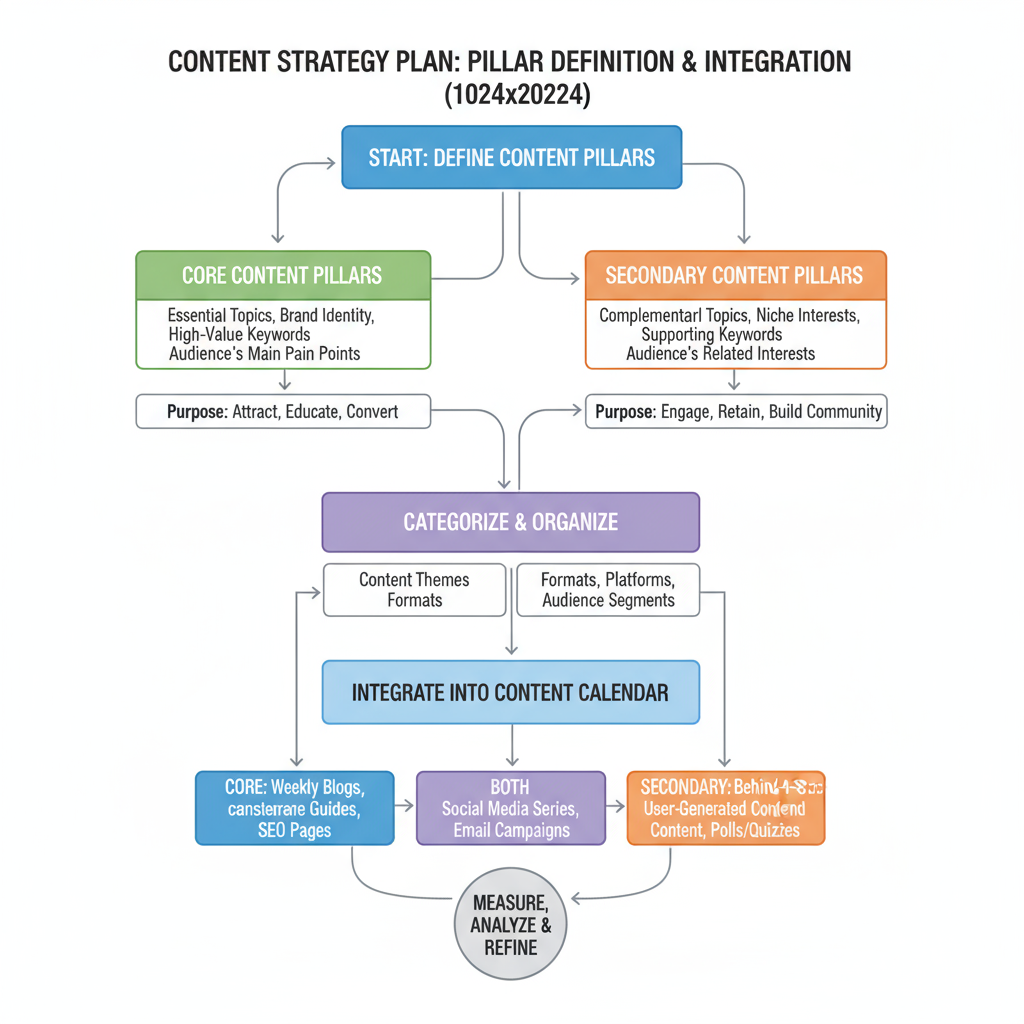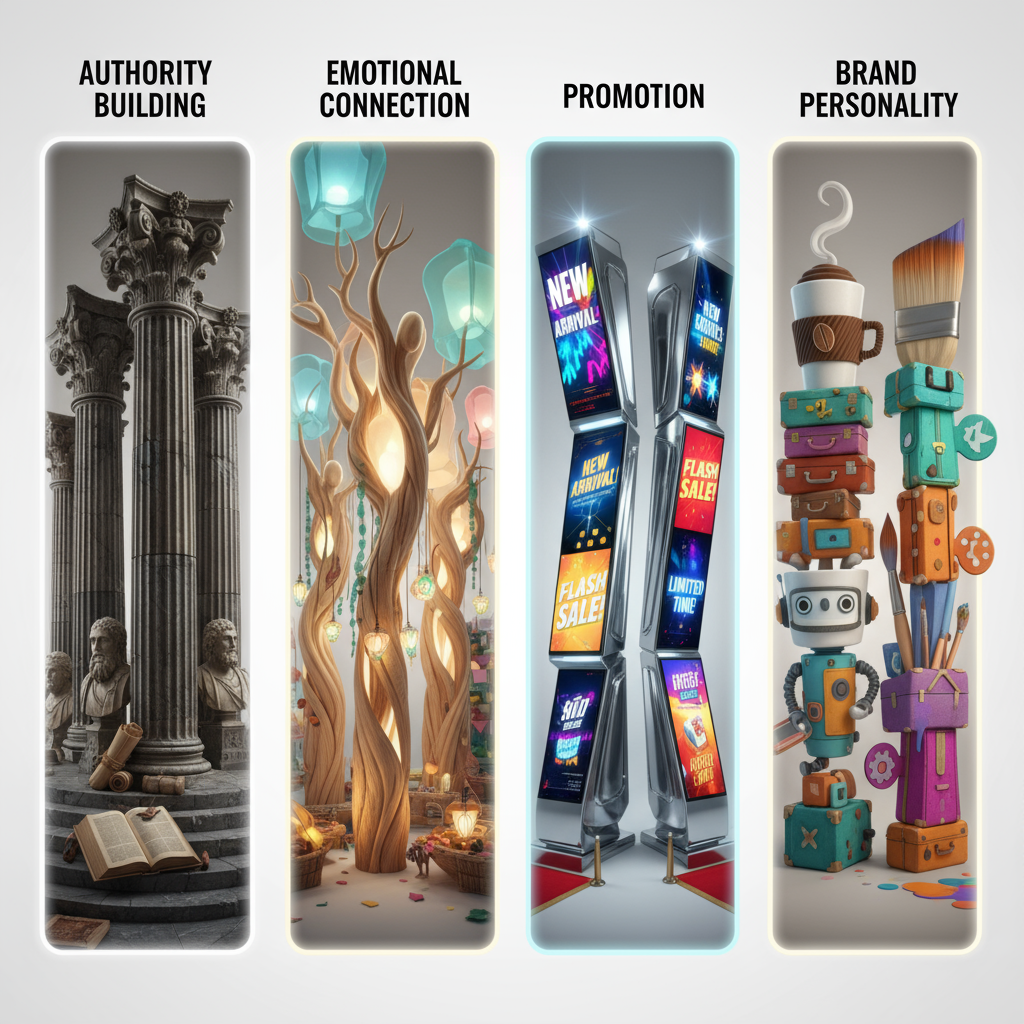Types of Content Pillars for an Effective Content Strategy
Learn how to use core, secondary, educational, inspirational, promotional, and cultural content pillars to build a consistent and engaging brand strategy.

Introduction to Content Pillars and Their Role in Strategy
In the fast-paced world of digital marketing, having a structured system for content creation sets successful brands apart. Content pillars — the key themes or topic categories forming the foundation of your content strategy — are essential for ensuring every piece you publish is purposeful and aligned with your marketing goals. They guide your topics, tone, and chosen platforms, helping you deliver relevant and consistent messaging.
Whether you're a startup defining your brand voice or an established enterprise seeking cross-channel consistency, identifying your content pillars builds a cohesive framework that supports long-term audience engagement and solidifies brand identity.

---
Why Content Pillars Are Important for Consistent Branding
Consistency is one of the most powerful but often overlooked drivers in marketing success. Without it, brands risk sending mixed signals that erode trust. Content pillars serve as a compass, helping you:
- Maintain thematic consistency across channels.
- Align messaging tightly with business objectives.
- Ensure audience resonance through relevant topics.
- Streamline creative workflows with clear guidelines.
Think of pillars as brand “guardrails” — keeping campaigns on track while allowing room for creativity.
---
Core vs. Secondary Content Pillars Explained
A practical approach to designing a pillar strategy is to separate them into core and secondary categories:
| Type | Description | Example Topics |
|---|---|---|
| Core Pillars | Aligned directly with the brand mission and KPIs, these have the highest strategic priority. | Product innovation, thought leadership, customer success stories |
| Secondary Pillars | Broader supporting themes that enrich your message and build lifestyle or cultural connection. | Industry trends, lifestyle tips, cultural commentary |
Balancing core and secondary pillars ensures that your content remains relevant from both a business and audience perspective.
---
Educational and Informational Pillars for Authority Building
One of the most effective types of content pillars involves the educational or informational category. Use this to:
- Display industry expertise.
- Solve audience challenges.
- Offer actionable guidance.
- Share timely industry updates.
Examples:
- Step-by-step how-to tutorials.
- Whitepapers and original research.
- FAQ pages or explainer series.
- Industry best-practice roundups.
Consistently delivering value positions your brand as a credible, go-to source for information in the niche you serve.

---
Inspirational and Motivational Pillars for Emotional Impact
Inspirational pillars foster emotional connection, driving loyalty and advocacy. They align audiences to brand values, often through storytelling or uplifting content.
Tactics:
- Highlight authentic customer success stories.
- Share motivational quotes or messages.
- Showcase journeys of overcoming challenges.
By sparking emotion, these pillars deepen brand affinity and encourage organic engagement like shares and comments.
---
Promotional Pillars for Products, Services, and Offers
Contrary to misconceptions, promotional content is not inherently pushy if integrated wisely. It’s a critical pillar for driving conversions and revenue, but should work in balance with value-driven posts.
Effective Promotional Ideas:
- Launch announcements.
- Limited-time discounts.
- Product feature spotlights.
- Special events.
Rule of Thumb: Maintain an 80/20 mix — 80% educational or entertaining content, 20% promotional — to keep audiences receptive.
---
Community and Culture Pillars for Brand Personality
Your brand’s culture and community form a lasting emotional anchor. This pillar showcases the human side of your company.
Examples:
- Staff profiles or behind-the-scenes features.
- Highlights of philanthropic involvement.
- Seasonal celebrations.
- Visuals from community events.
Authenticity builds connection; audiences increasingly choose brands that align with their outlook and values.
---
Behind-the-Scenes Pillars for Humanizing Your Brand
Behind-the-scenes (BTS) content invites audiences into your processes and environment, reinforcing transparency.
BTS Content Ideas:
- Manufacturing or creative process videos.
- A team member’s “day in the life.”
- Office gatherings or brainstorm sessions.
- Sneak previews of upcoming projects.
These glimpses make your brand relatable, boosting engagement and trust.

---
Storytelling Pillars for Memorable Engagement
Narratives are timeless tools for connection. Storytelling pillars frame your messaging through relatable plots and emotional arcs.
Storytelling Elements:
- Characters — relatable personalities (staff, customers, brand mascots).
- Conflict — the challenge at hand.
- Resolution — your brand’s role in solving the problem.
Humans retain stories better than facts; weaving them into diverse formats — blogs, videos, social posts — elevates memorability.
---
Tips for Creating and Balancing Different Pillars in Your Content Plan
To implement a multi-pillar approach effectively:
- Audit Existing Content
- Identify which themes dominate and spot any gaps.
- Set Pillar-Specific Objectives
- Each pillar should serve a defined role, from awareness to conversion.
- Map Pillars to Buyer Journey
- Assign pillars to awareness, consideration, or decision stages.
- Maintain a Content Calendar
- Track and schedule to prevent overuse or underuse of any pillar.
- Analyze and Adjust
- Monitor engagement, conversions, and reach metrics and refine accordingly.
Sample Content Pillar Mapping Table:
| Pillar Type | Buyer Journey Stage | Example Asset |
|---|---|---|
| Educational | Awareness | Beginner’s Guide eBook |
| Promotional | Decision | Free Trial Landing Page |
| Storytelling | Consideration | Customer Case Study Video |
| Community | Awareness | Local Event Photo Album |
---
Summary and Next Steps
A balanced mix of different types of content pillars creates a well-rounded, consistent, and engaging online presence. Combining educational value with storytelling, promotional focus, cultural resonance, and inspirational messages builds a multidimensional brand identity that audiences connect with and trust.
Start by auditing your current content, defining clear objectives, and mapping pillars to your customer journey stages. Then, use a content calendar to manage execution and track results.
CTA: Implement these pillar strategies today to improve your content marketing performance and strengthen your brand’s impact across all channels.




